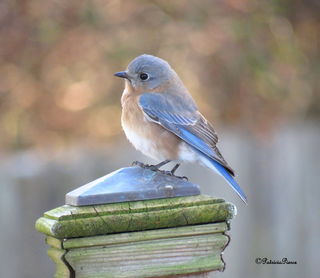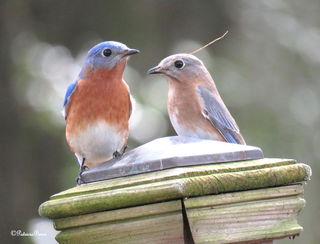Animal Behavior
Why Do Female Birds Sing?
Female bluebirds sing to strengthen and maintain the bond with their mates.
Posted August 26, 2019

Birdsong is often thought of as a male trait, but new research is changing that idea. Ornithologists have long known that many female tropical songbirds sing, but female song in North American and European species has gone largely unappreciated.
Evangeline Rose, a graduate student at the University of Maryland, Baltimore County, says female birdsong has been understudied for several reasons.
“In north temperate regions, females sing less often, are quieter, and tend to be cryptic – meaning they are duller and try to stay hidden. On the other hand, temperate males are really colorful and really loud,” she says. “It was easy for researchers to miss the quiet and hidden females and focus on the loud and colorful males.”
Rose also says there is evidence that male researchers are significantly less likely to study female song than are female researchers. Since the disciplines of ornithology and animal behavior were so male-dominated in the past, this is likely also a factor.
Our understanding of female birdsong has increased over the past few decades, but scientists still know relatively little about its function in temperate regions.

In a new study in the journal Behavioral Ecology, Rose and her colleagues examined this question in Eastern bluebirds (Sialia sialis). Female eastern bluebirds sing songs structurally equivalent to male songs but the purpose was unknown.
The researchers tested multiple hypotheses about female song function using a modeling framework and by presenting model animals to wild breeding pairs of bluebirds. Each of the model animals represented a different kind of threat. For instance, snakes are a threat to eggs and nestlings, small hawks are a predator of adult birds, and other bluebirds are a threat to the territory and resources of the focus pair of birds.
Analyses of behavioral responses and the statistical modeling both supported one hypothesis above all the others: pair communication.
“Females did not change their behavior or song rate significantly to any of the animal models,” says Rose. “And males most often responded to female song by approaching, singing, and performing a wing display in close proximity to the female.”
Specifically, Rose and her colleagues say their data suggest females sing to strengthen and maintain long-term pair bonds. Unlike many other temperate species, Eastern bluebirds breed together for multiple nest attempts each year and often remain together between years. Strengthening pair-bonds may be advantageous for bluebirds since every time a breeding pair comes back together for another nesting attempt (both within a single season and between years) they have better success.

Rose is continuing to look at repertoire size (how many song types a bird is able to sing) in female and male eastern bluebirds, as well as if female song structure changes in different functional contexts. She says there is a lot more we need to learn about female song.
“There has been almost a century and a half of research on male song, while studies on female song only started in earnest in the 1980s,” says Rose. “Female song seems to have more diverse functions between species than male song. There is still a lot we need to learn about which species have female song, how females use song, and how it is genetically, neurologically, and hormonally controlled.”
More broadly, Rose says that when biologists focus solely on males, they are missing a big part of the story.
“The work my lab has been doing on female song helped establish a new paradigm and a new set of questions for the original evolution of female song,” she says. “Our work thus provides a good case study of the importance of studying everything from ecology and evolution to physiology and disease with both sexes in mind.”
References
Rose, E. M., Coss, D. A., Haines, C. D., Danquah, S. A., Studds, C. E., and Omland, K. E. (2019). Why do females sing? -- Pair communication and other song functions in eastern bluebirds. Behavioral Ecology arz130. doi: 10.1093/beheco/arz130.


